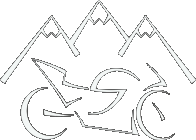Okay, so I was the only one to show up for the ride on Saturday, August 16th.. you know, that big rain-storm that hit the whole front-range. From Aurora to Estes to Loveland to Aurora. Rain pretty much the whole way...
People think I'm crazy, but there are ways to ride rain without ditching it. First off is GEAR. If you're doing long rides or you know you'll have rain, buy and pack a rain suit that you've hit with waterproofing. Throw this over your leathers (yes, make sure you have em) and you'll stay bone-dry wherever they are. Keep em in side-bags or have a pack. Make sure your boots are waterproof or spray em twice a season. Wet, cold feet don't shift or break well, and if you loose feeling, you loose control. Gloves... well, I had to buy neoprene fly-fishing gloves in Estes, but now I'll pack em when I know I might hit rain.
Now, for riding... with solid tires (DON'T HAVE SLICKS) you can do the speed-limit the whole way... trust me... just back off a bit more in corners and you'll stay rubber-side down. The real trick is watching for three things: blow-back from on-coming and in-tandem traffic, center-lane rise (and quality) as well as standing water.
For blow-back, you gotta keep reading what all traffic ahead if you is doing. Read as far ahead as you can and watch where the water is spraying, regardless of who it will be coming from. Just throttle up and down to keep out of that spray, and if you can't avoid it or don't see it coming, don't panic... just always remember what the line is in front of you and roll through the "blind spot" when you're getting soaked. If you're next to a guy hosing you, then back-off till your clear. Then either pace behind him or look for a drier patch (slanted pavement is always best) for where to pass.
For where to ride, you have have to make a choice on when the rain started. If it's pavement that just got wet, stay off that high-center portion of any lane. The oil and anti-freeze collect there, so fresh rain will lift it off a bit and make things that much more slick. Also, use the shoulders. There may be a bit of gravel, but there's no oil-slick at all and you're tires will hold.
Standing water is generally unavoidable. If you're alone on the road, you can cruise through it without too much trouble. But stay off the gas... coast through it and don't touch the friggin break. Once through, proceed normally but remember that your disks will be wet and won't grab as quickly or efficiently. In fact, remember that your disks will be wet during any rain and you need to buy extra space between you and anything you'll need to break for including vehicles, blow-back and corners.
The other catch is riding behind vehicles when you see them hit standing water. This is a biotch on some areas of I-25 and all over, really. The trick here is to get in behind one of the big rigs if you can, then trucks if you can manage it. Try and stay a bit closer than normal (while still giving you some breaking or swerving distance... then, keep your tires in the swath they'll cut in the standing water. This will put you in the trench of a lane, but if you're close enough to have your rubber hitting pavement before the standing water flows back, you'll be in great shape.
The down-side here is that you'll be getting some spray-back from the vehicle ahead, but with good gear, you should stay dry.
The other thing here is to try and find days and places where there's little or no traffic and then hit them when there is rain. Building up your confidence and skills will keep you from jerking brakes or dumping clutches at the wrong time.
So, hit that wet pavement without fear, remember these rules and you have a shot at turning a bad rain day into a great ride day.
Enjoy!





 Reply With Quote
Reply With Quote